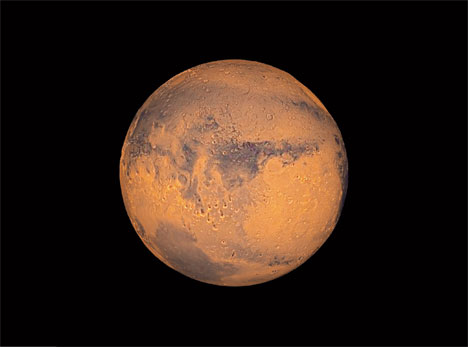
The last days of July 2018 bring a double delight for sky lovers, amateurs and astronomers.
On July 27, India and many other countries will observe the longest total lunar eclipse of the century around midnight Indian Standard Time. Moon will be under Earth's shadow and totally eclipsed for one hour and 43 minutes! Days later another spectacular celestial event is to enthrall and excite millions of people around the world.
Mars will be closest to Earth since 2003 on July 31. The Red Planet will be at its brightest since August 2003, when Mars made its closest approach to Earth in almost 60,000 years (since September 24, 57,617 BC).
Mars, the fourth planet from the Sun, orbits the Sun at a greater distance than Earth. As the distance from the Sun increases, the orbital period increases, too. While Earth takes a little more than 365 days to go round the Sun, Mars takes 687 days.
Because of the difference of the orbital speed and the orbital period, every 26 months or so, Earth passes between Mars and the Sun, bringing the two on exactly opposite sides of our planet. This is called Mars at opposition.
This year Mars will be at its opposition on July 27, only 51 days before it passes through its perihelion - its closest point relative to the Sun in its orbit. Since it will be quite close to Earth by that time, it will appear very bright and will be visible roughly after sunset and will remain in the sky till sunrise.
The Red Planet will shine very prominently in our night sky. At this time, it is easier to see the Red Planet clearly with telescopes or even with the naked eye. The Red Planet comes close enough to gift us such exceptional viewing occasions only once or twice every 15 or 17 years.
Because of the elliptical orbits of the planets, Earth and Mars come close to each other around the time of opposition. The closest approach of Mars this time will be on July 31 and it will look brighter and bigger than it has been since August 2003. The Red Planet's next closest approach, though not as close as on 2003, will not occur till 2035. Mars will come closer to Earth than it was in 2003 only in 2287 (August 29).
On July 31, Mars will be around 57.6 million km from Earth. In 2003, the distance was 55.7 million km, the closest in almost 60,000 years. The next opposition of Mars will be on October 6, 2020, but it will be a little further away, 61.76 million km from Earth.
Mars being our next-door neighbour in the solar system, there has been a tremendous interest about it among the general public, as well as students and scientists. Numerous space missions have been sent to Mars, which have given us information about the possible presence of water on it and, subsequently, the possibility of the presence of life forms in the past. Though no definitive proof of life has been discovered on Mars, the idea has generated a lot of interest.
What is going to happen on July 31 has triggered much excitement among sky lovers and space enthusiasts, as apparent from posts on social media and various online forums.
In August 2003, a hoax that Mars would appear as big as the moon became viral. Since then, the hoax resurfaces almost every year around August. It may happen this year, too.
At its closest approach this time, Mars will be only 24.3 arc seconds across and nowhere close to the size of the moon, which is 75 times bigger in diameter as it appears.
It is safe to watch Mars with the naked eye. If sky enthusiasts want to see the details, they can use a telescope with a diameter of 4 inch or more. Bigger the telescope, better the resolution of the surface features.
Astronomers have observed a dust storm engulf Mars. One hopes the storm will subside in time and the planet can be viewed in its full glory. The present position of Mars is such that the south polar region and the ice caps on it will be nicely visible from Earth through a moderate-sized telescope.
Just after sunset one should look close to the east-southeastern horizon to view this bright planet, appearing 1.8 times brighter than the biggest planet of the solar system, Jupiter.
Wishing everybody an enjoyable viewing of this celestial event.










